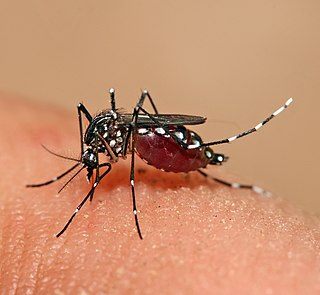
Mosquitoes, the Culicidae, are a family of small flies consisting of 3,600 species. The word mosquito is Spanish and Portuguese for little fly. Mosquitoes have a slender segmented body, one pair of wings, three pairs of long hair-like legs, and specialized, highly elongated, piercing-sucking mouthparts. All mosquitoes drink nectar from flowers; females of some species have in addition adapted to drink blood. The group diversified during the Cretaceous period. Evolutionary biologists view mosquitoes as micropredators, small animals that parasitise larger ones by drinking their blood without immediately killing them. Medical parasitologists view mosquitoes instead as vectors of disease, carrying protozoan parasites or bacterial or viral pathogens from one host to another.

Aedes albopictus, from the mosquito (Culicidae) family, also known as the (Asian) tiger mosquito or forest mosquito, is a mosquito native to the tropical and subtropical areas of Southeast Asia. In the past few centuries, however, this species has spread to many countries through the transport of goods and international travel. It is characterized by the white bands on its legs and body.

Aedes is a genus of mosquitoes originally found in tropical and subtropical zones, but now found on all continents except Antarctica. Some species have been spread by human activity: Aedes albopictus, a particularly invasive species, was spread to the Americas, including the United States, in the 1980s, by the used-tire trade.

Aedes aegypti, the yellow fever mosquito, is a mosquito that can spread dengue fever, chikungunya, Zika fever, Mayaro and yellow fever viruses, and other disease agents. The mosquito can be recognized by black and white markings on its legs and a marking in the form of a lyre on the upper surface of its thorax. This mosquito originated in Africa, but is now found in tropical, subtropical and temperate regions throughout the world.
Philip James Barraud was an English entomologist who specialised in mosquitoes. He wrote the Fauna of British India volume on the mosquitoes.
Ochlerotatus is a genus of mosquito. Until 2000, it was ranked as a subgenus of Aedes, but after Reinert's work, the clade was upgraded to the level of a genus. This change has resulted in the renaming of many subgenus species, and many aedini-related taxa are undergoing taxonomic revisions. Some authors are still using traditional taxonomic names in their publications.
Aedes capensis is a species of mosquito primarily found in forests in sub-Saharan Africa.

Aedes pembaensis is a mosquito.

Aedes canadensis, the woodland pool mosquito, is an aggressive, day biting mosquito that can be a vector of a number of diseases which is found mainly in eastern North America.
Francisco Edlagan Baisas was a Philippine entomologist regarded as the "Dean of Philippine Culicidologists" whose "contributions to the knowledge of Philippine mosquitoes is without measure". His passing was described as the end of "an era which saw the elucidation of the malaria vectors of the Philippines and great progress made in the control of a disease which had accounted for as many as 2,000,000 cases annually in those islands."
Aedes africanus is a species of mosquito that is found on the continent of Africa with the exclusion of Madagascar. Aedes aegypti and Aedes africanus are the two main yellow fever vector species in Zambia. Aedes africanus is mainly found in tropical forests not near wetlands.
Aedes vittatus is a species of mosquito that was first described in 1861 as Culex vittatus from specimens collected on Corsica. In 2000, the species was transferred to the newly erected subgenus Fredwardsius as the type species representing the subgenus.
Aedes luteocephalus is an African species that is a demonstrated or suspected vector of several important arboviral diseases of humans. First described in 1907 as Stegomyia luteocephala, the species is currently classified in the genus Aedes, subgenus Stegomyia.
Aedes malayensis was first described in 1963 by Australian entomologist Donald Henry Colless as a subspecies of Aedes scutellaris from males collected at Pulau Hantu, Keppel Harbor, Singapore. In 1972 the subspecies was elevated to species status by Yiau-Min Huang, although the move was disputed by the original describer on biological as opposed to morphological principles.
Lutzia is a genus of mosquitos. First described in 1903 by Frederick Vincent Theobald, it includes species whose larval stages exhibit predatory behavior. The type species is Lutzia bigoti.

Sabethes or canopy mosquitos are primarily an arboreal genus, breeding in plant cavities. The type species is Sabethes locuples, first described by Jean-Baptiste Robineau-Desvoidy in 1827.

Aedes japonicus, commonly known as the Asian bush mosquito or the Asian rock pool mosquito, was first described by Theobald in 1901 from Tokyo, Japan. They are competent arbovirus vectors known to transmit the West Nile virus as well as Japanese and St. Louis encephalitis. They are listed as an invasive species by the Global Invasive Species Database.

Aedini is a mosquito tribe in the subfamily Culicinae. It is the main tribe of mosquitoes with 1256 species classified in 81 genera and two groups incertae sedis.

Ellinor Catherine Cunningham van Someren was a Ugandan-born British medical entomologist. She specialised in mosquitoes, identifying at least thirty-three new species while employed by the Kenyan Health Service and partaking in scientific surveys in Kenya, Tanzania, and Somalia. In 1962, she was a consultant on yellow fever to the World Health Organization. Van Someren was appointed an Officer of the Order of the British Empire in the Queen's Birthday Honours in 1974 for diplomatic services in scientific research overseas.







